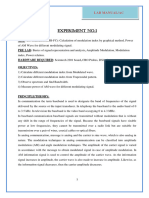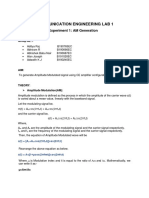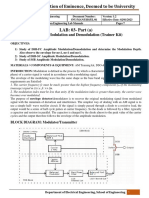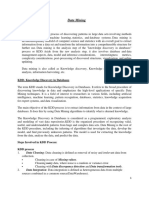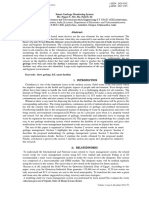Manual for Communication Systems Laboratory
(EEE/ECE F311)
Prepared by
Faculty & Laboratory Staff
Dept. EEE
BITS Pilani, Hyderabad
Date: August 2019
Page 1
� Experiment 3: Amplitude Modulation (With carrier) and
Demodulation
Aim: This experiment is intended to make the student to perform experiments on Amplitude
Modulation (with carrier) and its demodulation on Emona Telecoms-Trainer 101 kit.
Equipment Required: Emona Telecom Trainer Kit 101, DSO and connecting patch cards etc.
Page 2
�A – Generation of AM with Carrier:
AM with carrier follows the equation y(t) = (A + m(t) ) * Cos (2*pi*fc*t); where, m(t)is the
message signal, A is the carrier amplitude and fc is the carrier frequency.
In this experiment, let the Message Signal and carrier be sinusoids of frequencies 2KHz and 100
KHz, respectively.
1. Locate the master signal generator on the Emona Kit. Measure and note the frequencies and
peak to peak amplitudes of the 2KHz & 100 KHz signals, as available on the kit.
2. We would like the amplitude of the message signal be 1V. To adjust it, you may use the
amplifier available in the ADDER Module Block. Make the following connections (Fig. 1).
Adjust (using the screw driver provided) the gain associated with input A of the adder module
so as to have a waveform on DSO with 2V peak to peak amplitude. Measure it and tabulate
in Table 1.
Figure 1: Amplitude adjustment for Figure 2: Amplitude adjustment
Message signal for Carrier signal
3. Let the carrier amplitude be A = 3Volt. To obtain this value, you may use the connections as
in Fig 2. First, take out the connections made to the A-input of the adder. Adjust the gain
knob of the B input of the adder module and the variable DC source knob to obtain a DC
voltage of 3 Volts. Measure this using DSO. For this measurement, the channel 2 of DSO
should be in DC coupling mode. Measure it and tabulate in Table 1.
4. To implement (A + m(t)), connect back the input to A-input of the adder module. The
connection diagram should be as shown below. Do not change any settings of the gain knobs
and the variable DC knob. Observe the DC shift in the message signal (mean value). Measure
it and tabulate in Table 1. To measure mean value of y(t) = (A + m(t) ), make sure that the
Channel 2 is in DC coupling mode.
Page 3
� Figure 3: Amplitude adjustment for DC Bias signal
5. To implement y(t) = (A + m(t) ) * Cos (2*pi*fc*t), we need Cos (2*pi*fc*t). with fc = 100
Khz and amplitude of 1 V. For this, connect the 100 KHz cosine signal to CH1 of the DSO
and measure its peak-to- peak amplitude. You may observe that the peak-to- peak amplitude
is not 2V. To adjust it to 2V, we need to take the help of a gain module. Locate the buffer
module on the Emona Kit and use the following connection diagram. Note that Buffer is an
amplifier and has a gain adjustment control provided. Adjust the gain control knob to obtain
a 2V peak-to-peak 100 KHz cosine wave. Measure it and tabulate in Table 1.
Figure 4: Amplitude adjustment for Carrier signal
6. Now to implement y(t) = (A + m(t)) * Cos (2*pi*fc*t), use the following connection diagram.
There are 2 multiplier blocks on the board. Use the lower block that accepts signals with DC
bias.
Figure 5: Generation of AM signal with carrier
Page 4
�7. Display the message and modulated waveforms on the DSO with the message signal in the
upper half and the AM signal in the lower half. Make sure that the display is triggered with
Message signal. Sketch the modulated signal in your observation books.
Figure 6: AM signal With Carrier (time domain)
Old DSO (Model No. TDS 2012C)
8. Go to “MATH” mode and observe the spectrum on the screen. Set the Operation to FFT and
Source to CH2. You may use the “Window” as “Flattop” and the FFT Zoom to X10. Using
the combination of Horizontal position and scale knobs, try to get 3 distinct peaks on the
screen. As you change the Horizontal Position knob, you will observe on the top of the screen,
in red color, POS: xxxx KHz. This indicates the frequency value of the white inverted arrow
on the top of the screen. Adjust the position knob to get POS:100Khz. Then the middle peak
of the spectrum coincides with the position of the vertical arrow.
New DSO (Model No. TBS 1102B-EDU)
Press ‘FFT” (yellow color button) button on the “Vertical” panel on the DSO and set the
Source to CH2. You may use the “Window” as “Flattop” and the FFT Zoom to X10.Using the
combination of Horizontal position and scale knobs, try to get 3 distinct peaks on the screen.
As you change the Horizontal Position knob, you will observe on the top of the screen, in red
color, POS: xxxx KHz. This indicates the frequency value of the white inverted arrow on the
top of the screen. Adjust the position knob to get POS:100Khz. Then the middle peak of the
spectrum coincides with the position of the vertical arrow.
Page 5
� Figure 7: Spectrum of AM signal with carrier
(frequency domain)
9. What is the significance of these three peaks?
10. Using cursor mode, measure the frequencies and power of each of the peaks and tabulate in
Table 1.
11. Is the total power in sidebands is equal to the message power in modulated signal?
12. Is the carrier power in time domain is same as measured in frequency domain?
Table 1. Time & Spectral Domain Measurements on AM Signal (with carrier)
Messag Message Carrie Carrier Message DC Frequenc Power Frequenc Power Frequenc Power
e Power (W, r Power (W, Power in Bias y of First of first y of of y of third of
Amplit dBW) Ampli dBW) modulate Value Peak Peak second secon Peak Third
ude (V) tude d signal = of Peak d Peak
A (V) message (A + Peak
power /2
m(t)
)
B – Modulation Index Calculations:
1. Modulation index can be calculated from the message & carrier amplitudes. Calculate and fill
the appropriate column (4) in Table 2. It can also be calculated as in column (5), where P & Q
are taken from the modulated signal. See the picture below. Compare the modulation indices
from both calculations. Calculate the modulation efficiency as in column (6).
Page 6
� Figure 8: Modulation Index Measurement
Table 2.Modulation Index and Efficiency of AM Signal (with carrier)
P Q Modulatio
n Index =
Modulatio
(P- Single tone
Maximum n Index =
Q)/(P+Q)
Message (max(m(t)) Efficiency
Amplitude A /A (5)
Sl.
No (1) (2) (4)
Table 2: Modulation indices and Efficiencies
2. Next, we shall observe the efficiency of AM for a different Modulation index. For this, first
the DSO is kept in time domain display. Now, adjust the gain knob of the B input of the
adder module and the variable DC source knob such that the “Q” value, as indicated in
Figure 2, reduces to zero. The DSO screen would look like the one in the following picture.
Measure the P & Q values and calculate the Modulation index and the efficiency and
tabulate in Table 2.
Figure 9: AM signal With Carrier for = 1
Page 7
�Old DSO (Model No. TDS 2012C)
3. Go to “MATH” mode and observe the spectrum on the screen. Set the Operation to FFT
and Source to CH2. You may use the “Window” as “Flattop” and the FFT Zoom to X10.
Using the combination of Horizontal position and scale knobs, try to get 3 distinct peaks
on the screen.
New DSO (Model No. TBS 1102B-EDU)
Press ‘FFT” (yellow color button) button on the “Vertical” panel on the DSO and set the
Source to CH2. You may use the “Window” as “Flattop” and the FFT Zoom to X10. Using
the combination of Horizontal position and scale knobs, try to get 3 distinct peaks on the
screen.
Figure 10: Spectrum of AM signal With Carrier for = 1
4. Using cursor mode, measure the frequencies and power of each of the peaks. Answer the
following:
a. What is the power in each of the sidebands in dBW and Watts ?
b. What is the total power in both sidebands put together?
c. What is the carrier power in dBW and Watts?
d. Compute the efficiency: (usable message power / Carrier power + Message power).
e. Does this efficiency number matches with the one calculated from the time domain
measurements?
5. Bring back the DSO to time domain. Adjust the gain knob of the B input of the adder
module and the variable DC source knob such that over modulation occurs. The DSO
screen would look like the one in the following picture.
Page 8
� Figure 11: AM signal With Carrier for >1
Old DSO (Model No. TDS 2012C)
6. Go to “MATH” mode and observe the spectrum of over modulated signal on the screen.
New DSO (Model No. TBS 1102B-EDU)
6. Go to “FFT” mode and observe the spectrum of over modulated signal on the screen
Figure 12: Spectrum of AM signal With Carrier for >1
C –Demodulation of AM with Carrier:
Demodulation of AM with carrier is accomplished by using an envelope detector, which is
typically implemented using a rectifier and low-pass filter combination.
1. Generate an AM signal with carrier, with parameters as in Section A. Use the connection
diagram as in Fig.4 to demodulate a non over modulated AM signal.
Page 9
� Figure 13: Demodulation of AM signal with carrier
2. Capture the waveforms at point Z and also the Demodulated AM signal. How clean is the
demodulated Message? Comment on it.
3. Obtain the Spectra of signal at Point Z and comment on the observation. Note down all the
significant peaks (frequency and power levels). Can you explain the behavior from Fourier
series perspective?
4. Compare the Spectra of original message signal at Point X and the demodulated AM signal
(after the low pass filter) and note the power in dB in the spectral domain. Is there any loss
in the message power at the output of LPF compared to the input message signal power? If
yes explain the loss.
D –Conclusions:
1. List out your learnings from the experiments.
Page 10






























